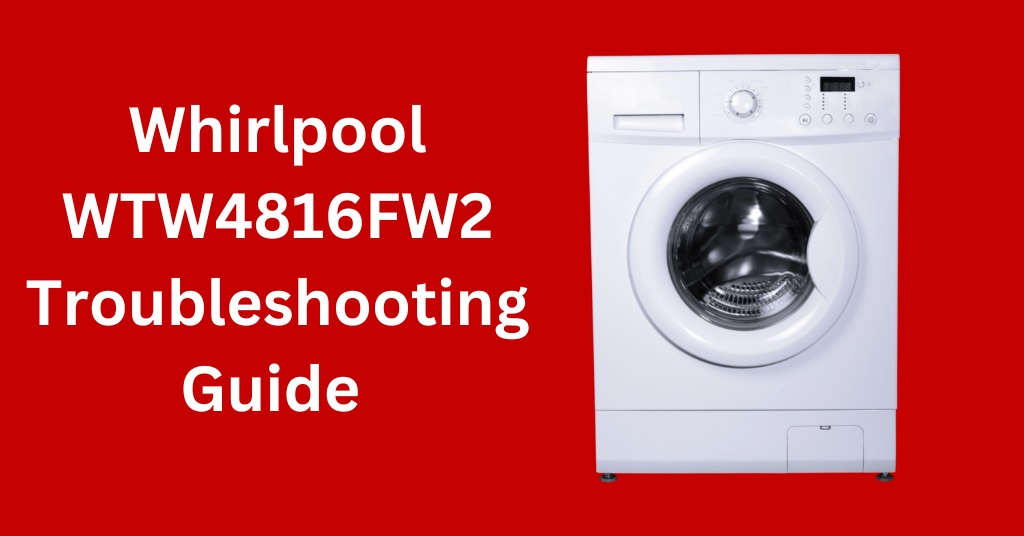Whirlpool is one of the latest reliability survey’s most reliable washing machine brands. Only a few customers report breakages before the first five years of use.
Whirlpool Cabrio washers have an average life expectancy of at least ten years, some even lasting as long as ten to thirteen years. But sometimes, it just happens that the washer won’t turn on, makes weird noises, or does not perform as you expect it to.
The Whirlpool WTW4816FW2 can also have many problems, and it is essential to understand this guide to fix it properly.
This article will discuss the steps you can take if your washer vibrates too much, is off-balance, makes weird noises, has water leaks, or is not performing as you expect it to.
What To Do When Whirlpool WTW4816FW2 Doesn’t Work?

Here are the problems that one may encounter using this washer, and their solutions.
1. Vibration and Off-Balance
The vibration comes off your washer mainly because the load is unbalanced. Off-balanced washers might be because the feet need to be in proper contact with the floor, or the washer may not be leveled.
Ensure that the front and rear feet of the washer are firmly in contact with the floor. This helps to level the washer properly to operate better.
Check the floor for flexing and sagging. If the floor is uneven, add a ¾ inches or 19 mm long piece of plywood under the washer to reduce the sound emitting from the washer’s off-balance.
You can also check the “Level the Washer” option in Installation Instructions.
An unbalanced load can also be the leading cause behind the vibration or off-balancing of your washer. Follow the steps below to ensure you follow the wash instructions properly.
- Make sure not to cramp up the washer. Dry items should be put into loose and open piles to avoid misbalancing.
- Adding wet items to the washer or more water to the basket could imbalance the washer.
- Wash smaller loads to reduce the imbalance. Refrain from tightly packing.
- Avoid single-washing items.
- While washing things such as jackets or windcheaters, especially the non-absorbent ones, make sure to use bulky items to balance the load.
- Refer to the “Cycle Guide” and “Using Your Washer” provided in the user’s guide and manual with the washer.
2. Noise
The noises emitting during a wash cycle on your Whirlpool washer might be because of objects stuck in the washer, load sensing, or basket deceleration.
Make sure to empty your pockets before putting them in a load. Items like coins and clips might fall between the basket during the cycle and block the pump drain.
Make sure to call a professional in case anything like this happens.
Metal items attached to the clothes or bags, such as snaps, buckles, or zippers, often touch against the basket surface and create noise. It is usually a clanking sound against the surface of the basket and persists throughout the cycle.
Usually, it is easy to differentiate between such sounds and the sound of damage or potential kinks.
Hearing occasional whirring, spraying, or streaming sounds at the end of the cycles is usual. It is just the washer draining at the end of the process, so you do not need to worry about it.
A slight humming or whirring sounds occur during load sensing or basket deceleration.
Load sensing, often done before the start of the cycle, measures mechanical force, mainly the weight of objects. The slight humming before the whirring sound during basket downshift also usually after starting the washer.
3. Water Leaks
Water leaks generally happen if the washer is not leveled correctly or the filling hose is not tightly attached.
The water may splash off the basket if the washer needs to be leveled correctly.
Make sure that you have crammed only the washer recommends. An unbalanced load may also lead to water leaks during the cycle.
Tighten the fill-hose connection and ensure all four fill-hose flat washers are properly seated to avoid water spilling.
Pull the drain hose from the washer cabinet and fasten it to the drainpipe or laundry tub. This is to tighten the drain-hose connection but not place tape over the drain opening.
A clogged sink or drainpipe may also be responsible for potential water leaks, so look for plumbing leaks around the house. Getting plumbing service done every year or two is also recommended.
Improper loading results in the basket getting out of alignment and causes water to splash off the tub.
What Are The Most Common Problems With A Whirlpool Washing Machine?
Following is a list of the most common problems with a Whirlpool washing machine:
- The washer making unusual noises.
- Washer not starting.
- The washer lid does not lock.
- LD error code appears (showing a problem with the drain pump system).
- The washer leaves light deposits on dark-colored clothes.
- Rust spots appearing on the washer lid.
- The washer emits a weird, burned plastic smell.
How To Reset A Whirlpool Washer?
Follow the steps below to reset your Whirlpool washing machine
- Turn off the washer.
- Turn the mode dial to NORMAL.
- Turn the dial counterclockwise, one click left, clockwise for three clicks, counterclockwise for one click, and then clockwise for one click.
If your washer is still not functioning correctly, try the Cabrio reset procedure.
- Touch any button on the display pad to remove the existing error code displayed on the screen.
- Press PAUSE or CANCEL to end it, and choose a cycle before pressing START.
- After the process completes, pull the plug from the power.
- Wait for five minutes before plugging the machine back in.
- Run a test load to see if the panel displays the error code.
Final Remarks
It is frustrating to figure out the problems or the error codes displayed on the Whirlpool WTW4816FW2. I tried to make that procedure easier through this article.
Here’s a quick recap.
Luckily, despite being a complex machine, there are chances that problems such as vibration and off-balanced devices, whirring noise, or water leaks can be easily solved at home without any electrical knowledge.

My name is Rick Kinney and I am the founder of ExHandyman. I have worked as a handyman for many years, and fixing stuff is my greatest pleasure in life.
